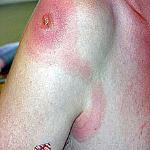05 April 2010
Scientists in Scotland say they may have found a new treatment for sleeping sickness, which could be ready for clinical trial within 18 months. The disease is fatal and infects around 60,000 people in Africa annually.
Sleeping sickness is spread by a parasite that infects the central nervous system and, if left untreated, moves to the spinal column and brain, resulting in mental confusion and eventual death.
Paul Wyatt led the study at the Drug Discovery for Tropical Diseases program at the University of Dundee. He says their research has identified an "Achilles' heel" of the parasite - an enzyme that is needed for the parasite's survival.
"We've identified a weakness in the parasite that can be exploited with drugs. And the other breakthrough we've made is we've actually discovered some molecules which are on the way to being potential drugs for the disease as well," he said.
The research was published in the latest edition of the Britain-based scientific journal Nature.
"We have a number of hurdles still ahead," said Wyatt. "We have to make sure that the compound will be sufficiently efficacious to be used in the clinical setting, it has to be safe, and again we can make the drug sufficiently cheaply that it will be appropriate for the use in the clinical setting."
There are already two drugs available to fight sleeping sickness, but they are both problematic. One is an arsenic-based drug that kills five percent of users. The other, eflornithine, is expensive, requires prolonged hospital treatment and is only partially effective.
Francois Chappuis is a specialist in Neglected Tropical Diseases with the international health organization Doctors Without Borders.
He says an inexpensive and easy-to-use medicine for sleeping sickness is badly needed. "In areas where the sleeping sickness is still very prevalent such as remote areas of some central African countries, which are by the way very unstable areas, it will be also crucial to have simpler treatment and obviously oral treatment would be the best," he said.

www.cdc.gov
Lesion on shoulder, which is symptomatic of Sleeping SicknessSleeping sickness is one of a group of diseases known as "neglected tropical diseases." According to the World Health Organization, one sixth of the world's population suffers from one or more of the neglected diseases.
Chappuis says those diseases have a low profile and scarce financial investment, compared to HIV/AIDS, tuberculosis and malaria. However, the neglected diseases affect most severely those who are poor and disadvantaged.
"These patients, they live in very remote areas. And you know we should not talk about neglected disease, but we should talk about neglected populations. These populations, they have no political voice - neither at national or international levels," He added.
The World Health Organization estimates that between 50,000 and 70,000 people in sub-Saharan Africa are infected with sleeping sickness, which is spread by the tsetse fly. The organization says 60 million people are at risk of infection.